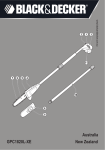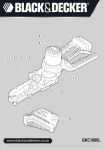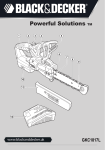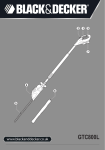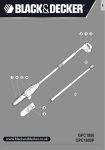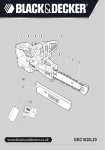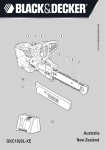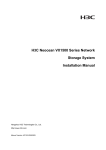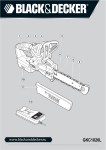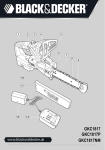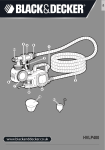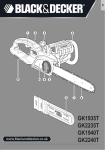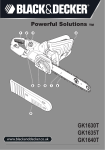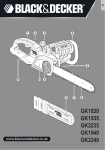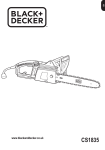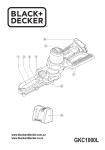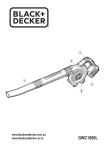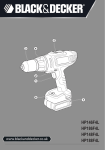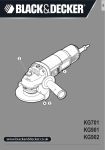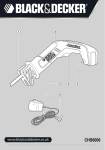Download Black & Decker GPC1800L User's Manual
Transcript
GPC1800L 2 3 ENGLISH (Original instructions) Intended use Your Black & Decker cordless pole pruner has been designed for pruning trees. This tool is intended for consumer use only. Your Black & Decker charger has been designed for charging Black & Decker batteries of the type supplied with this tool. Safety instructions General power tool safety warnings Warning! Read all safety warnings and all instructions. Failure to follow the warnings and instructions listed below may result in electric shock, fire and/or serious injury.. Save all warnings and instructions for future reference. The term “power tool” in all of the warnings listed below refers to your mains operated (corded) power tool or battery operated (cordless) power tool. Work area safety • Keep work area clean and well lit. Cluttered or dark areas invite accidents. • Do not operate power tools in explosive atmospheres, such as in the presence of flammable liquids, gases or dust. Power tools create sparks which may ignite the dust or fumes. • Keep children and bystanders away while operating a power tool. Distractions can cause you to lose control. Electrical safety • Power tool plugs must match the outlet. Never modify the plug in any way. Do not use any adapter plugs with earthed (grounded) power tools. Unmodified plugs and matching outlets will reduce risk of electric shock. • Avoid body contact with earthed or grounded surfaces such as pipes, radiators, ranges and refrigerators. There is an increased risk of electric shock if your body is earthed or grounded. • Do not expose power tools to rain or wet conditions. Water entering a power tool will increase the risk of electric shock. 4 • Do not abuse the cord. Never use the cord for carrying, pulling or unplugging the power tool. Keep cord away from heat, oil, sharp edges or moving parts. Damaged or entangled cords increase the risk of electric shock. • When operating a power tool outdoors, use an extension cord suitable for outdoor use. Use of a cord suitable for outdoor use reduces the risk of electric shock. • If operating a power tool in a damp location is unavoidable, use a residual current device (RCD) protected supply. Use of an RCD reduces the risk of electric shock. Personal safety • Stay alert, watch what you are doing and use common sense when operating a power tool. Do not use a power tool while you are tired or under the influence of drugs, alcohol or medication. A moment of inattention while operating power tools may result in serious personal injury. • Use personal protective equipment. Always wear eye protection. Protective equipment such as dust mask, non-skid safety shoes, hard hat, or hearing protection used for appropriate conditions will reduce personal injuries. • Prevent unintentional starting. Ensure the switch is in the off-position before connecting to power source and/or battery pack, picking up or carrying the tool. Carrying power tools with your finger on the switch or energising power tools that have the switch on invites accidents. • Remove any adjusting key or wrench before turning the power tool on. A wrench or a key left attached to a rotating part of the power tool may result in personal injury. • Do not overreach. Keep proper footing and balance at all times. This enables better control of the power tool in unexpected situations. • Dress properly. Do not wear loose clothing or jewellery. Keep your hair, clothing and gloves away from moving parts. Loose clothes, jewellery or long hair can be caught in moving parts. • If devices are provided for the connection of dust extraction and collection facilities, ensure these are connected and properly used. Use of dust collection can reduce dust-related hazards. (Original instructions) Power tool use and care • Do not force the power tool. Use the correct power tool for your application. The correct power tool will do the job better and safer at the rate for which it was designed. • Do not use the power tool if the switch does not turn it on and off. Any power tool that cannot be controlled with the switch is dangerous and must be repaired. • Disconnect the plug from the power source and/or the battery pack from the power tool before making any adjustments, changing accessories, or storing power tools. Such preventive safety measures reduce the risk of starting the power tool accidentally. • Store idle power tools out of the reach of children and do not allow persons unfamiliar with the power tool or these instructions to operate the power tool. Power tools are dangerous in the hands of untrained users. • Maintain power tools. Check for misalignment or binding of moving parts, breakage of parts and any other condition that may affect the power tools operation. If damaged, have the power tool repaired before use. Many accidents are caused by poorly maintained power tools. • Keep cutting tools sharp and clean. Properly maintained cutting tools with sharp cutting edges are less likely to bind and are easier to control. • Use the power tool, accessories and tool bits etc., in accordance with these instructions, taking into account the working conditions and the work to be performed. Use of the power tool for operations different from those intended could result in a hazardous situation. Battery tool use and care • Recharge only with the charger specified by the manufacturer. A charger that is suitable for one type of battery pack may create a risk of fire when used with another battery pack. • Use power tools only with specifically designated battery packs. Use of any other battery packs may create a risk of injury and fire. • When battery pack is not in use, keep it away from other metal objects, like paper clips, coins, keys, nails, screws, or other small metal objects, that can make a connection from one terminal to another. Shorting the battery terminals together may cause burns or a fire. ENGLISH • Under abusive conditions, liquid may be ejected from the battery; avoid contact. If contact accidentally occurs, flush with water. If liquid contacts eyes, additionally seek medical help. Liquid ejected from the battery may cause irritation or burns. Service • Have your power tool serviced by a qualified repair person using only identical replacement parts. This will ensure that the safety of the power tool is maintained. Additional safety instructions for pole pruners The intended use is described in this instruction manual. Do not use the tool for purposes not intended; for example do not use the tool to fell trees. The use of any accessory or attachment or performance of any operation with this tool other than those recommended in this instruction manual may present a risk of personal injury. • Wear close fitting and protective clothing including a safety helmet with visor/goggles, ear protectors, non-skid safety footwear, protective bib trousers and strong leather gloves. • Always position yourself out of the path of falling branches. • The safe distance between a branch to be felled and bystanders, buildings and other objects is at least 2 1/2 times the length of the branch. Any bystander, building or object within this distance is at risk from being struck by the falling branch. • Pre-plan a safe exit from falling trees or branches. Ensure the exit route is clear of obstacles that would prevent or hinder movement. Remember wet grass and freshly cut bark is slippery. • Ensure someone is nearby (but at a safe distance) in case of an accident. • Do not use the tool while standing in a tree, on a ladder or on any other unstable surface. • Keep proper footing and balance at all times. • Hold the tool firmly with both hands when the motor is running. • Do not let the moving chain contact any object at the tip of the guide bar. • Start cutting only with the chain moving at full speed. • Do not attempt to enter a previous cut. Always make a fresh cut. • Watch for shifting branches or other forces that could close a cut and pinch or fall into the chain. 5 ENGLISH (Original instructions) • Do not attempt to cut a branch when the diameter of the branch exceeds the cutting length of the tool. • Always remove the battery from the tool and place the chain cover over the chain when storing or transporting the tool. • Keep the saw chain sharp and properly tensioned. Check the tension at regular intervals. • Switch the tool off, allow the chain to stop and remove the battery from the tool before carrying out any adjustment, servicing or maintenance. • Only use genuine replacement parts and accessories. • Carry the pole pruner by the handle with the cutter blade stopped. When transporting or storing the pole pruner always fit the cutting device cover and dismantle it into its component parts. Proper handling of the pole pruner will reduce possible personal injury and injury to others. Residual risks Additional residual risks may arise when using the tool which may not be included in the enclosed safety warnings. These risks can arise from misuse, prolonged use etc. Even with the application of the relevant safety regulations and the implementation of safety devices, certain residual risks can not be avoided. These include: • Injuries caused by touching any rotating/moving parts. • Injuries caused when changing any parts, blades or accessories. • Injuries caused by prolonged use of a tool. When using any tool for prolonged periods ensure you take regular breaks. • Impairment of hearing. • Health hazards caused by breathing dust developed when using your tool (example:working with wood, especially oak, beech and MDF.) Vibration The declared vibration emission values stated in the technical data and the declaration of conformity have been measured in accordance with a standard test method provided by EN 60745 and may be used for comparing one tool with another. The declared vibration emission value may also be used in a preliminary assessment of exposure. 6 Warning! The vibration emission value during actual use of the power tool can differ from the declared value depending on the ways in which the tool is used. The vibration level may increase above the level stated. When assessing vibration exposure to determine safety measures required by 2002/44/EC to protect persons regularly using power tools in employment, an estimation of vibration exposure should consider, the actual conditions of use and the way the tool is used, including taking account of all parts of the operating cycle such as the times when the tool is switched off and when it is running idle in addition to the trigger time. Pruning Before attempting to prune a tree, ensure there are not by-laws or regulations that would prohibit or control the felling of the tree. • Be aware of the direction a branch may fall. Consider all conditions that may affect the direction of fall, including: --the length and weight of the branch to be cut --the intended direction of fall --any unusual heavy limb structure or decay --the presence of surrounding trees and obstacles, --including overhead lines --the intertwinement with other branches --the speed and direction of the wind. • Consider access to the tree limb. Tree branches are liable to swing towards the tree trunk. In addition to the user, any bystander, building or object below the branch is at risk of being struck by the branch. Safety of others • This appliance is not intended for use by persons (including children) with reduced physical, sensory or mental capabilities, or lack of experience and knowledge, unless they have been given supervision or instruction concerning use of the appliance by a person responsible for the their safety. • Children should be supervised to ensure that they do not play with the appliance. (Original instructions) Warning symbols The following warning symbols are found on the tool: Warning! To reduce the risk of injury, the user must read the instruction manual. Do not use the tool in wet conditions or expose it to rain. Always wear head and eye protection. Wear non-slip safety footwear. Beware of falling objects. Keep bystanders away. ENGLISH • Do not damage/deform the battery pack either by puncture or impact, as this may create a risk of injury and fire. • Do not charge damaged batteries. • Under extreme conditions, battery leakage may occur. When you notice liquid on the batteries Carefully wipe the liquid off using a cloth. Avoid skin contact. • In case of skin or eye contact, follow the instrucitons below. Warning! The battery fluid may cause personal injury or damage to property. In case of skin contact, immediately rinse with water. If redness, pain or irritation occurs seek medical attention. In case of eye contact, rinse immediately with clean water and seek medical attention. Chargers 10 m Electrocution hazard. Keep at least 10 m away from overhead lines. To ensure continued safe operation, check the chain tension as described in this manual after every 10 minutes of use, and adjust back to a clearance of 3 mm as required. Oil the chain after every 10 minutes of use Direction of rotation of the chain. Warning! Do not touch chain at the chip ejection point. Additional safety instructions for batteries and chargers Batteries • • • • Never attempt to open for any reason. Do not expose the battery to water. Do not expose the battery to heat. Do not store in locations where the temperature may exceed 40 °C. • Charge only at ambient temperatures between 10 °C and 40 °C. • Charge only using the charger provided with the applaince/tool. Using the wrong charger could result in an electric shock or overheating of the battery. • When disposing of batteries, follow the instructions given in the section “Protecting the environment”. Your charger has been desinged for a specific voltage. Always check that the mains voltage corresponds to the voltage on the rating plate. Warning! Never attempt to replace the charger unit with a regular mains plug. • Use your Black & Decker charger only to charge the battery in the applaince/tool with which it was supplied. Other batteries could burst, causing personal injury and damage. • Never attempt to charge non-rechargeable batteries. • If the supply cord is damaged, it must be replaced by the manufacturer or an authorised Black & Decker Service Centre in order to avoid a hazard. • Do not expose the charger to water. • Do not open the charger. • Do not probe the charger. • The appliance/tool/battery must be placed in a well ventilated area when charging. Labels on the charger The following symbols are found on your charger: The charger is intended for indoor use only Read the instruction manual before use. 7 ENGLISH 130oC +40ºC +10ºC (Original instructions) The charger automatically shuts off if the ambient temperature becomes too high. As soon as the ambient temperature has cooled down, the charger will resume operating. Charge only at ambient temperatures between 10 °C and 40 °C. Electrical safety Your charger is double insulated; therefore no earth wire is required. Always check that the mains voltage corresponds to the voltage on the rating plate. Never attempt to replace the charger unit with a regular mains plug. Overview 1. On/off switch 2. Lock-off button 3. Main handle 4. Saw head 5. Sprocket cover 6. Guide bar 7. Chain 8. Chain sheath 9. Lubrication bottle 10.Extension tube 11.Battery Fig. A 12.Charger Assembly Warning! Before assembly, remove the battery from the tool. Fitting and removing the battery (fig. B) • To fit the battery (11), line it up with the receptacle on the tool. Slide the battery into the receptacle and push until the battery snaps into place. • To remove the battery, push the release button (13) while at the same time pulling the battery out of the receptacle. Warning! To prevent accidental operation, ensure that the battery is removed and that the chain sheath is in place on the saw chain before performing the following operations. Failure to do this could result in serious personal injury. 8 Fitting the saw head (fig. C) The saw head can be fitted directly to the handle in order to achieve standard reach. • Align the groove on the outside of the coupling end of the handle (3) with the tongue on the inside of the coupling end of the saw head (4). Push the saw head (4) onto the handle (3). • Slide the collar (14) down and rotate it clockwise until it is fully tightened. Warning! Periodically check the connections to ensure that they are tightened securely. Extending the saw head (fig. D) The maximum reach can be achieved by fitting the extension tube (10) between the saw head (4) and the handle (3). • Align the groove on the outside of the coupling end of the handle (3) with the tongue on the inside of the coupling end of the extension tube (10). • Push the extension tube (10) onto the handle (3). • Slide the collar (15) down and rotate it clockwise until it is fully tightened. • Align the groove on the outside of the coupling end of the extension tube (10) with the tongue on the inside of the coupling end of the saw head (4). • Push the saw head (4) onto the extension tube (10). • Slide the collar (14) down and rotate it clockwise until it is fully tightened. Warning! Periodically check the connections to ensure that they are tightened securely. Removing the saw head (fig. C & D) If the extension tube (10) is fitted, the saw head must be removed first. • To remove the saw head (4), rest the handle (3) on the ground, loosen the collar (14) and take off the saw head. Use Warning! Let the tool work at its own pace. Do not overload. Charging the battery (fig. A) The battery needs to be charged before first use and whenever it fails to produce sufficient power on jobs that were easily done before. When charging the battery for the first time, or after prolonged storage, it will only accept an 80% charge. (Original instructions) After several charge and discharge cycles, the battery will attain full capacity. The battery may become warm while charging; this is normal and does not indicate a problem. Switching on and off (fig. E) Warning! Do not charge the battery at ambient temperatures below 10 °C or above 40 °C. Recommended charging temperature: approx. 24°C. Note: The charger will not charge a battery if the cell temperature is below approximately 0 °C or above 60 °C. The battery should be left in the charger and the charger will begin to charge automatically when the cell temperature warms up or cools down. • To charge the battery (11), remove it from the tool and insert it into the charger (12). The battery will only fit into the charger in one way. Do not force. Be sure that the battery is fully seated in the charger. • Plug in the charger and switch on at the mains. The charging indicator (24) will flash continuously (slowly). The charge is complete when the charging indicator (9) lights continuously. The charger and the battery can be left connected indefinitely with the LED illuminated. The LED will change to flashing (charging) state as the charger occasionally tops off the battery charge. The charging indicator (24) will be lit as long as the battery is connected to the plugged-in charger. • Charge discharged batteries within 1 week. Battery life will be greatly diminished if stored in a discharged state. • Switching on Charging indicators If the charger detects a problem with the battery, the charging indicator (24) will flash at a fast rate. Proceed as follows: • Re-insert the battery (11). • If the charging indicators continues flashing at a fast rate, use a different battery to determine if the charging process works properly. • If the replaced battery charges correctly, the original battery is defective and should be returned to a service centre for recycling. • If the new battery gives the same indication as the original battery, take the charger to be tested at an authorised services centre. Note: It may take as long as 15 minutes to determine that the battery is defective. If the battery is too hot of too cold, the LED will alternately blink fast and slow, one flash at each speed and repeat. ENGLISH For your safety, this tool is equipped with a double switching system. This system prevents starting the tool inadvertently. • Push the lock-off button (2) backward using your thumb and at the same time squeeze the on/off switch (1). • Release the lock-off button (2). Switching off • Release the on/off switch (1). Warning! Never attempt to lock a switch in the on position. Pruning (fig. F) • Make sure the tool is running at full speed before making a cut. • Hold the tool firmly in place to avoid possible bouncing or sideways movement of the tool. • Guide the tool through the branch using light pressure. When cutting heavy branches, where a partial cut may splinter and damage the tree, proceed as follows: --Make the first cut 15 cm from the tree trunk on the underside of the limb. Use the top of the guide bar (7) to make this cut. --Cut one third through the diameter of the limb. Then cut down from the top. Cleaning, maintenance and storage Your Black & Decker corded/cordless appliance/ tool has been designed to operate over a long period of time with a minimum of maintenance. Continuous satisfactory operation depends upon proper tool care and regular cleaning. Warning! Before performing any maintencance on corded/cordless power tools: • Switch off and unplug the appliance/tool • Or switch off and remove the battery from the appliance/tool if the appliance/tool has a separate battery pack • Or run the battery down completely if it is integral and then switch off • Unplug the charger before cleaning it. Your charger does not require any maintenance apart from regular cleaning. Regularly clean the ventilation slots in you appliance/tool/charger using a soft brush or dry cloth. 9 ENGLISH (Original instructions) Regularly clean the motor houseing using a damp cloth. Do not use any abrasive or solvent-based cleaner. Regularly open the chuck and tap it to remove any dust from the interior (when fitted). After use and before storage • Regularly clean the ventilation slots with a clean, dry paint brush. • To clean the tool, use only mild soap and a damp cloth. Never let any liquid get inside the tool and never immerse any part of the tool into liquid. • Remove debris using a hard brush. • Lubricate the chain with oil. Installing and removing the saw chain (fig. G & H) Warning! Always wear protective gloves when installing or removing the saw chain. The saw chain is sharp and can cut you when it is not running. • Place the tool on a firm and stable surface. • Loosen the screws (16) using the Allen key provided. Remove the screws. • Remove the sprocket cover (5) and the bar clamp (17). • Turn the screw (18) counterclockwise to allow the guide bar (6) to recede and to reduce the tension on the saw chain (7). • Remove the old saw chain from the sprocket (19) and the guide bar (6). • Place the new saw chain in the groove of the guide bar and around the sprocket. Make sure that the teeth are facing the correct direction by matching the arrow on the saw chain with the arrow on the housing. • Make sure that the slot (20) in the guide bar is over the location pins (21) and that the hole (22) below the slot is located over the adjustment pin (23). • Re-fit the sprocket cover (5) and the bar clamp (17) and the screws (16). • Tighten the screws (16) using the Allen key provided. • Adjust the chain tension as described below. To ensure continued safe operation, the chain and guide bar must only be replaced with original Black & Decker parts. Replacement chain part number A6158 replacement guide bar part number 623381-00. 10 Checking and adjusting the chain tension (fig. G) • Check the saw chain tension. The tension is correct when the saw chain (7) snaps back after being pulled away 3 mm from the saw chain bar with light force from the middle finger and thumb. There should be no ‘sag’ between the guide bar (6) and the saw chain (7) on the underside. To adjust the tension: • Loosen the screws (16). • Turn the screw (18) clockwise. Warning! Do not over-tension the chain as this will lead to excessive wear and will reduce the life of the bar and chain. • Once the chain tension is correct, tighten the screws (18). Warning! When the saw chain is new, check the tension frequently during the first two hours of use as a new saw chain stretches slightly. Oiling the chain The saw chain must be oiled before each use and after cleaning using only the correct grade of oil (cat. no. A6027). • Oil the whole saw chain (7) evenly using the applicator (9). Storage When the tool will not be used for several months, ideally leave the battery connected to the charger. Otherwise proceed as follows: • Fully charge the battery. • Remove the battery from the tool. • Store the tool and battery in a secure and dry location. • The storage temperature must always remain in the range of +10 °C to +40 °C. Place the battery on a level surface. • Before using the tool after prolonged storage, fully charge the battery again. Protecting the environment Separate collection. This product must not be disposed of with normal household waste. Should you find one day that your Black & Decker product needs replacement, or if it is of no further use to you, do not dispose of it with household waste. Make this product available for separate collection. ENGLISH (Original instructions) Separate collection of used products and packaging allows materials to be recycled and used again. Reuse of recycled materials helps prevent environmental pollution and reduces the demand for raw materials. Local regulations may provide for separate collection of electrical products from the household, at municipal waste sites or by the retailer when you purchase a new product. Black & Decker provides a facility for the collection and recycling of Black & Decker products once they have reached the end of their working life. To take advantage of this service please return your product to any authorised repair agent who will collect them on our behalf. You can check the location of your nearest authorised repair agent by contacting your local Black & Decker office at the address indicated in this manual. Alternatively, a list of authorised Black & Decker repair agents and full details of our aftersales service and contacts are available on the Internet at: www.2helpU.com Batteries • • • • At the end of their useful life, discard batteries with due care for our environment Do not short-circuit the battery terminals. Do not dispose of the battery(s) in a fire as this may result in a risk of personal injury or an Explosion. Run the battery down completely, then remove it from the tool. Batteries are recyclable. Place the battery(s) in a suitable packaging to ensure that the terminals cannot be short-circuited. Take them to any authorised repair agent or a local recycling station. Technical data GPC1800L (H1) Voltage VDC 18 No-load chain speed m/min 114 Weight Kg 3.5 Max. Cutting Length cm 17 A1518L Battery Voltage VDC 18 Capacity Ah 1.5 Weight Kg 0.45 Charger 9053954* Input Voltage VAC 230 Output Voltage VDC 21 Current A 1.9 Approx. charge time h 8 Level of sound power according to EN ISO 3744: LWA = 98 dB(A), uncertainty (K) = 3 dB(A) Level of sound pressure according to EN ISO 11203: LPA = 78 dB(A), uncertainty (K) = 3 dB(A) Vibration total values (triax vector sum) determined according to EN 60745 Cutting wood Vibration emission value ah= <2.5 m/ s2 Uncertainty K= <1.5 m/ s2 11 ENGLISH (Original instructions) EC - Declaration of Conformity MACHINERY DIRECTIVE GPC1800L Black & Decker declares that these products described under “technical data” are in compliance with: 2006/42/EC EN60745-1, These products also comply with Directive 2004/108/EC. For more information, please contact Black & Decker at the following address or refer to the back of the manual. The undersigned is responsible for compilation of the technical file and makes this declaration on behalf of Black & Decker. Kevin Hewitt Vice-President Global Engineering Black & Decker Europe, 210 Bath Road, Slough, Berkshire, SL1 3YD United Kingdom 20-01-2010 Guarantee Black & Decker is confident of the quality of its products and offers an outstanding guarantee. This guarantee statement is in addition to and in no way prejudices your statutory rights. The guarantee is valid within the territories of the Member States of the European Union and the European Free Trade Area. If a Black & Decker product becomes defective due to faulty materials, workmanship or lack of conformity, within 24 months from the date of purchase, Black & Decker guarantees to replace defective parts, repair products subjected to fair wear and tear or replace such products to ensure minimum inconvenience to the customer unless: • The product has been used for trade, professional or hire purposes; • The product has been subjected to misuse or neglect; • The product has sustained damage through foreign objects, substances or accidents; • Repairs have been attempted by persons other than authorised repair agents or Black & Decker service staff. To claim on the guarantee, you will need to submit proof of purchase to the seller or an authorised repair agent. You can check the location of your nearest authorised repair agent by contacting your local Black & Decker office at the address indicated in this manual. Alternatively, a list of authorised Black & Decker repair agents and full details of our after-sales service and contacts are available on the Internet at: www.2helpU.com Please visit our web site www.blackanddecker. co.uk to register your new Black & Decker product and to be kept up to date on new products and special offers. Further information on the Black & Decker brand and our range of products is available at: www.blackanddecker.co.uk 12 13 14 ENGLISH Do not forget to register your product! www.blackanddecker.co.uk/productregistration Register your product online at www.blackanddecker.co.uk/productregistration or send your name, surname and product code to Black & Decker in your country. 15 Australia Black & Decker (Australia) Pty. Ltd. 20 Fletcher Road, Mooroolbark, Victoria, 3138 Tel. 03-8720 5100 Fax 03-9727 5940 New Zealand Black & Decker 5 Te Apunga Place Mt Wellington Auckland 1060 Tel. +64 9 259 1133 Fax +64 9 259 1122 United Kingdom Black & Decker 210 Bath Road Slough, Berkshire SL1 3YD Tel. 01753 511234 Fax 01753 551155 Helpline 01753 574277 90560539 REV-0 01/2010
















